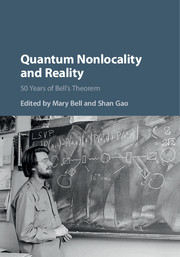Book contents
- Frontmatter
- Contents
- Contributors
- Preface
- Preface
- Part I John Stewart Bell: The Physicist
- Part II Bell's Theorem
- Part III Nonlocality: Illusion or Reality?
- 9 Strengthening Bell's Theorem: Removing the Hidden-Variable Assumption
- 10 Is Any Theory Compatible with the Quantum Predictions Necessarily Nonlocal?
- 11 Local Causality, Probability and Explanation
- 12 The Bell Inequality and the Many-Worlds Interpretation
- 13 Quantum Solipsism and Nonlocality
- 14 Lessons of Bell's Theorem: Nonlocality, Yes; Action at a Distance, Not Necessarily
- 15 Bell Nonlocality, Hardy's Paradox and Hyperplane Dependence
- 16 Some Thoughts on Quantum Nonlocality and Its Apparent Incompatibility with Relativity
- 17 A Reasonable Thing That Just Might Work
- 18 Weak Values and Quantum Nonlocality
- Part IV Nonlocal Realistic Theories
- Index
- References
9 - Strengthening Bell's Theorem: Removing the Hidden-Variable Assumption
from Part III - Nonlocality: Illusion or Reality?
Published online by Cambridge University Press: 05 September 2016
- Frontmatter
- Contents
- Contributors
- Preface
- Preface
- Part I John Stewart Bell: The Physicist
- Part II Bell's Theorem
- Part III Nonlocality: Illusion or Reality?
- 9 Strengthening Bell's Theorem: Removing the Hidden-Variable Assumption
- 10 Is Any Theory Compatible with the Quantum Predictions Necessarily Nonlocal?
- 11 Local Causality, Probability and Explanation
- 12 The Bell Inequality and the Many-Worlds Interpretation
- 13 Quantum Solipsism and Nonlocality
- 14 Lessons of Bell's Theorem: Nonlocality, Yes; Action at a Distance, Not Necessarily
- 15 Bell Nonlocality, Hardy's Paradox and Hyperplane Dependence
- 16 Some Thoughts on Quantum Nonlocality and Its Apparent Incompatibility with Relativity
- 17 A Reasonable Thing That Just Might Work
- 18 Weak Values and Quantum Nonlocality
- Part IV Nonlocal Realistic Theories
- Index
- References
Summary
Spooky Action at a Distance
In the context of correlation experiments involving pairs of experiments performed at very nearly the same time in very far-apart experimental regions, Einstein famously said [1],
But on one supposition we should in my opinion hold absolutely fast: “The real factual situation of the system S2 is independent of what is done with system S1 which is spatially separated from the former.”
This demand is incompatible with the basic ideas of standard (Copenhagen/orthodox) quantum mechanics, which makes two relevant claims:
(1) Experimenters in the two labs make “local free choices” that determine which experiments will be performed in their respective labs. These choices are free in the sense of not being predetermined by the prior history of the physically described aspects of the universe, and they are localized in the sense that the physical effects of these free choices are inserted into the physically described aspects of the universe only within the laboratory in which the associated experiment is being performed.
(2) These choices of what is done with the system being measured in one lab can (because of a measurement-induced global collapse of the quantum state) influence the outcome of the experiment performed at very close to the same time in the very faraway lab.
This influence of what is done with the system being measured in one region upon the outcome appearing at very nearly the same time in a very faraway lab was called “spooky action at a distance” by Einstein, and was rejected by him as a possible feature of “reality.”
John Bell's Quasi-classical Statistical Theory
Responding to the seeming existence in the quantum world of “spooky actions,” John Bell [2] proposed a possible alternative to the standard approach that might conceivably be able to reconcile quantum spookiness with “reality.” This alternative approach rests on the fact that quantum mechanics is a statistical theory.We already have in physics a statistical theory called “classical statistical mechanics.”
- Type
- Chapter
- Information
- Quantum Nonlocality and Reality50 Years of Bell's Theorem, pp. 151 - 159Publisher: Cambridge University PressPrint publication year: 2016



